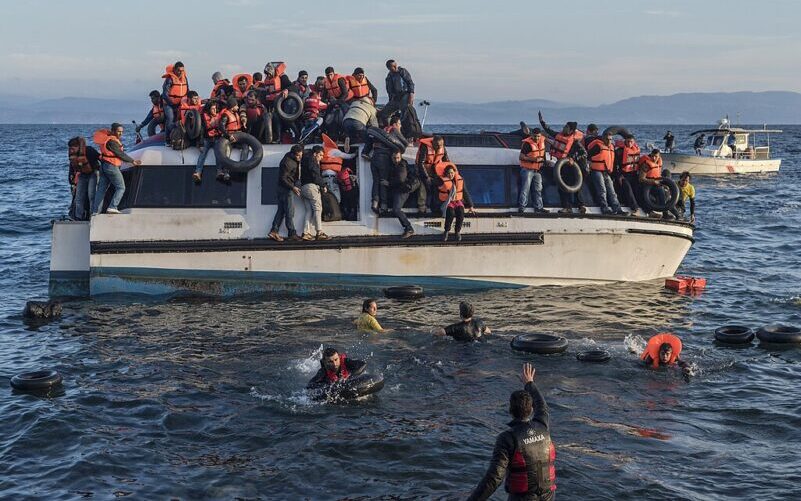The escalating costs of climate change, rising inequality, a global trade war, and a cost-of-living crunch; it’s all the fault of immigrants. Social scientist Alan Gamlen explains why so many think it’s true.
When economies sputter, when public services strain, when communities feel fragmented, immigration becomes the symbol for everything wrong with globalisation.
It offers politicians a visceral, easy-to-grasp story: ‘Your housing is unaffordable because of them. Your hospital is overcrowded because of them. Your jobs are threatened because of them.”
Never mind that the evidence shows otherwise—that migration generally boosts economies, raises overall output without depressing local wages, and is a net fiscal positive.
The hard truth is complicated, while the populist narrative is simple. Faced with a “spaghetti chart” of interconnected crises—pandemics, supply shocks, inflation, housing pressures—people gravitate toward the single, tidy explanation: immigration is to blame.
That’s exactly what Pauline Hanson, the leader of Australia’s far-right One Nation political party, recently told Australia’s The Saturday Paper ($), to explain her party’s recent lift in the polls: “People have lost hope … wherever you look – mass migration, climate change, the education system, escalating crime, the cost of living, job security, being able to buy a house – the whole country is in one hell of a mess, and that’s why they’re angry and they want a change.”
Immigration. Why Australia should favour skilled migrants over family reunions
Enter the ‘strongman’
Once immigration is cast as the source of all ills, the next step is equally simple: only a strongman can stop it. The democratic process, messy and pluralistic, is portrayed as weak and complicit. The promise of authoritarians is neat and compelling: ‘I alone can fix it. Give me power, and I will close the borders, protect your jobs, restore your community.’
This is the story Donald Trump told in 2016, branding Mexican migrants as criminals and rapists, and insisting that only a wall and a “tough guy” could save America.
Variations of the same narrative fuelled Brexit in the UK—“take back control”—and continue to animate far-right movements across Europe.
What began as marginal authoritarian nostalgia has re-entered the mainstream, carried by the promise of simplicity and control in an age of complexity. The question now is how to avoid the wholesale collapse that has occurred at this point in past cycles.
The flash mob effect
What sets today’s anti-immigration movements apart is how they organise.
They grow online, out of sight of mainstream politics. In closed networks, they immerse isolated individuals in an alternative reality, where the notion that “immigrants are ruining everything” is taken as fact. These groups feed on each other’s anger, hidden from view, until they erupt suddenly into the streets as marches or protests.
What we are seeing are ‘political flash mobs’. They look sudden, but most are the result of months or years of online incubation. Like vaccine conspiracy theories, anti-immigrant myths spread fast across borders, pushed by the viral logic of social media. These digital echo-chambers make fringe views feel mainstream and give authoritarian leaders a ready-made army of loyal supporters.
And it’s not just the far right. Social media has reshaped politics everywhere. People once scattered and silenced have gained power by linking online. The rise of LGBTQ politics shows this: people once isolated by stigma found they were not alone, built communities, and organised at a scale that was impossible before.
That new strength has reshaped the left of politics and become central to today’s culture wars.
Online platforms act like accelerants. They let both fringe and minority groups build solidarity, create closed worlds, and mobilise out of sight. When these movements surface—whether in campaigns for minority rights or marches against immigration—they seem sudden. But they are the product of new forms of digital cohesion that have destabilised traditional politics on both sides.
The migration state
Far-Right politics in Europe and the US differ from Australia’s. This is partly because migration shapes Australia’s identity more deeply:
Over half the population was either born abroad themselves or has a parent who was.
It is hard to cast people as “outsiders” when nearly everyone, except Indigenous groups, descends from recent immigrants.
Compulsory voting strengthens this effect. Unlike in Europe or the US, where parties rally extremes to boost turnout, Australian politicians must win the median voter—often an immigrant or the child of one.
But there is another reason. Australia is what political scientists call a “migration state”. While garrison states focus on security and welfare states focus on population health, the central purpose of migration states is to control population movement.
That migration policy emerges from a large ecosystem of institutions across government, academia, the press, and civil society, keeping migration at tolerable levels and creating checks against extreme political reactions. As a result, major immigration policy shifts are rare: changes are usually small and handled by bureaucrats rather than politicians.
Migration in Australia is thus not just policy but part of the nation’s identity and state machinery. This stability has shielded it from the immigration-driven turmoil seen in Britain with Brexit and in the US with Trump. Though Australia has more foreign-born residents than either, its debates are calmer, thanks to both national identity and long-term state capacity.
For historical reasons, Europe and the US have long maintained laissez-faire systems with functionally open borders, and they rely on weak, reactive migration policies to mimic control.
Meanwhile, Australia has built a durable system that treats controlled migration as a normal part of society. This steadiness has helped it avoid the populist upheavals shaking other democracies.
International praise for Australia’s migration system often centres on the controversial “stop the boats” policy. In the UK, some argue its harsh deterrence spared Australia the populist upheavals seen elsewhere. But this view is misguided.
“Stop the boats” has not stopped bogus asylum claims. Most come by plane, not boat. And while its architects were focusing on boat turn-backs, they were also quietly dismantling Australia’s visa compliance capabilities. This allowed a surge of copy-paste applications, which have overwhelmed the asylum system.
Unlike boat arrivals, few of these applicants have been recognised as genuine refugees.
By August 2025, more than 100,000 had been denied protection visas but not deported,
far exceeding the numbers from any past boat arrivals. But this issue attracts little attention, because stories of arrivals by plane lack the drama of “invading boats.”
Europeans, meanwhile, have embraced the superstition that stopping boats equals migration control. It may look like control—and thus make some people feel reassured. But it comforts without delivering. Tormenting asylum seekers may look tough, but it’s not the same thing as real migration control.
To say “stop the boats” has worked is also to ignore its staggering costs: A$12 billion between 2012 and 2024, ruined lives, weakened institutions, and a diminished reputation abroad. Even if it deterred some, it is an ugly bargain: punishing the few to scare the many.
The broader lesson is that controlling asylum is not the same as controlling migration. Australia has fumbled asylum but kept its wider migration system relatively steady, sustaining public trust.
Irregular flows remain small not because of turn-backs, but because of a strong migration state.
“Stop the boats” cannot be copied: it only appears to “work” because of Australia’s deeper institutions, which Europe lacks.
A democratic path forward
What is needed now is not the false simplicity of scapegoating, but an honest reckoning with complexity. The crises faced by all liberal democracies, such as unaffordable living costs, extreme inequalities, energy disruption, pandemics, political polarisation, and unchecked digital transformation, are real,
but they are not caused by immigration.
Orderly and regular immigration remains essential to the economies, cultures, and demographic futures of industrialised societies. The real challenge is to better manage migration’s externalities: ensuring affordable housing, investing in infrastructure, supporting social cohesion, and maintaining trust in public institutions.
The alternative is to let exclusion, polarisation and resentment fester, allowing authoritarians to sell the lie that democracy has failed and only they can save us. That is a dangerous path, as history has shown too many times before.
Liberal democracies stand at a crossroads on issues of migration. One road leads to stronger democratic institutions capable of tackling socio-cultural complexity with honesty. The other leads to walls, scapegoats, and strongmen.
A longer version of this article originally published under Creative Commons by 360info™.
Alan Gamlen is a social scientist specialising in large-scale interdisciplinary comparative research using quantitative and qualitative research methods. He is the Founding Director of the ANU Migration Hub and a Professor in the School of Regulation and Global Governance at ANU.

